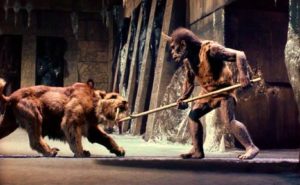Sinbad and the Eye of the Tiger
Rating: ***
Origin: UK, 1977
Director: Sam Wanamaker
Source: Viavision Blu-Ray

After the success of Golden Voyage, Columbia Pictures and Ray Harryhausen decided to up their game by shooting the third Sinbad movie at eye-popping locations in Spain, Malta, and Jordan, including the actual ruins of Petra. Then I guess they figured no further improvements were needed, because they hired mediocre director Sam Wanamaker, a journeyman unable to mitigate the pacing problems of the story, which was already burdened by a dull and generic script by Beverly Cross. The cast is bland as well, featuring the charisma-free Patrick Wayne (son of John) as Sinbad, and the vacant Taryn Power (daughter of Tyrone) as Dione, the wizard’s telepathic daughter. Jane Seymour as Princess Farah gets to do some decent acting in a couple of early scenes, but then the movie forgets she has any character and demotes her to the role of not-much-clothes horse. The best actors, as usual, are cast as the magicians, Margaret Whiting as the transforming sorceress Zenobia, and Patrick Troughton (the Second Doctor) as Melanthius, gray and looking just like Gandalf minus the hat. The film’s saving grace, as always, is the stop-motion artistry of Harryhausen and his wonderful creatures.
The plot follows the tried-and-true quest structure, with Sinbad and company on a perilous journey to find a cure for Farah’s brother, Prince Kassim, whom Zenobia has transformed into a baboon. This animated primate, with its humanlike gestures and expressions, is entirely convincing, and ranks with Harryhausen’s best work. Zenobia also gets a first-rate animated companion in Minaton, a bronze minotaur golem with a clockwork heart and an endless reservoir of superhuman strength. With the baboon in almost every scene with Sinbad, and Minaton ever-present with Zenobia, Eye of the Tiger probably features more onscreen creature-time than any other Harryhausen epic.
The journey is the usual parade of wonders interrupted by fantasy mêlées. It’s a tribute to Harryhausen’s skill—and an indictment of Wanamaker’s failings—that the animated combats are far better choreographed than the live-action fights. In the middle of the film, as Sinbad’s ship sails toward arctic Hyperborea, pursued by Zenobia in a bronze boat powered by the untiring Minaton, the pacing sags in a miasma of fog, stock footage of icebergs, and a dumb battle with a giant walrus, possibly the least-cool Harryhausen creation ever. The pace picks up again when they reach Hyperborea, where Sinbad and friends encounter an over-sized pre-human they call Trog. Instead of the expected combat pitting Trog and his great bone club against the scimitars of Sinbad’s crew, Kassim the baboon befriends the primitive creature, and it trustingly joins their party. The friendly nonverbal interactions between Trog and the baboon that follow are delightful, and the animated creatures establish an emotional connection stronger than any between the movie’s “real” actors.
As usual, the climactic scene is set in an ancient temple, an Arctic pyramid with a magic ever-swirling Jacuzzi inside. This confrontation between good and evil is overlong and entirely predictable, and some fine monster-wrestling notwithstanding, you just wish they’d hurry up and get it over with. The wrestling comes courtesy of an ice-locked saber-toothed tiger, which in accordance with the ironclad Law of Frozen Prehistoric Beasts gets thawed out to menace the heroes. Once the final fight is over the film blessedly cuts straight to the end credits, which play over the coronation of the rehumanized Prince Kassim, while the rest of the good guys smile in bland approval. That’s fine: we don’t really need any character closure with them anyway, since none of them have half the heart and soul of Harryhausen’s noble beasts.